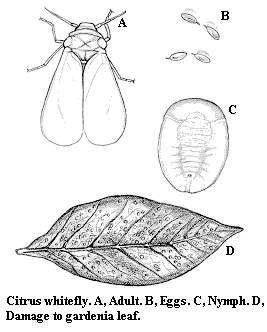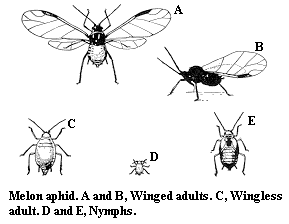Key to Gardenia Pests
Gardenia or cape jasmine, with its showy, fragrant white flowers and glossy, deep-green leaves, is one of the most delightful shrubs in the landscape. Although gardenias are not winter hardy for the upper Piedmont and Mountain areas, about 155,000 are produced each year by Southern nurserymen.
Various scale insects and spider mites feed on gardenias, though the most commonly reported insects are whiteflies, Japanese wax scales, and aphids.
- Citrus whitefly – The leaves are coated with honeydew and sooty mold. Flat, pale-green scales (about 1.5 mm long) and occasionally whiteflies are found on the leaf bottoms.
- Japanese wax scale – White, waxy blobs (up to 6 mm in diameter), often accompanied by sooty mold, appear on limbs and twigs.
- Melon aphid – New growth is curled and stunted by small, green or brown aphids feeding on leaves and new shoots.
- Twospotted spider mite – Tiny chlorotic dots or stipples appear on the upper leaf surface; tiny mites or eggs appear on the lower surface.
Citrus Whitefly
Citrus whitefly, Dialeurodes citri (Ash mead), Aleyrodidae, HEMIPTERA
DESCRIPTION
Adult – The adult is a small, mothlike insect, orange but covered by a snow-white, waxy bloom.
Egg – Almost microscopic, the egg is pale yellow-green.
Crawler – Tiny and pale green, the crawler has six legs, two antennae, and two red eyespots.
Nymph – The flattened nymph is pale green and scalelike.
BIOLOGY
Distribution – The citrus whitefly was introduced from Asia. Until the advent of synthetic organic pesticides, this pest caused an estimated loss of 45 to 50 percent of the citrus crops in Florida and the Gulf states. Several infestations in California have been eradicated. Among many other host plants, gardenias seem to be exceptionally susceptible. In fact, one of the infestations eradicated in California (at considerable expense) originated from a gardenia that had been smuggled into the state.
Host Plants – The citrus whitefly has been reported on 38 genera of evergreen and deciduous plants. Preferred host plants include chinaberry, all varieties of citrus, gardenia, privet, prickly ash, and Japanese persimmon.
Damage – Adult citrus whiteflies damage their host plants directly by ovipositing and feeding. Immature citrus whiteflies suck much sap from the leaves, although no quantitative work has determined exactly how much damage this causes.
The honeydew excreted by the feeding whiteflies provides an excellent medium for the sooty mold fungus Capnodium citri. It coats the leaves and stems of infested plants, shading them from sunlight. The number, size, and quality of citrus fruit are reduced; heavily infested gardenias, black with sooty mold, eventually drop their leaves prematurely.
Life History – Each female citrus whitefly may lay up to 125 eggs, which are partially inserted into the lower leaf surface. In heavy infestations, eggs may be so numerous that leaves are malformed and growth is impaired. The eggs hatch in 6 to 21 days, and tiny, pale-green crawlers move about the plant seeking a place to feed. When they insert their long, threadlike mouthparts into the lower leaf surface, they become immobile. After the first molt, legs and antennae are lost. After two additional molts, the pupae form. The adults finally emerge from T-shaped splits in the pupal skins. There are three broods each year in Alabama and Florida. Summer broods require about 2 months for development; the last brood overwinters in the immature stage.
CONTROL
At least three species of lady beetles are known to feed on citrus whitefly crawlers and nymphs, but they are seldom numerous enough to effect real control. A tiny wasp has recently been introduced into Florida to help control citrus whiteflies.
Insecticides should be applied in late spring before the emergence of first-generation adult whiteflies. The spray should be directed to the undersides of the leaves. For specific chemical controls, see the current state extension recommendations.
Melon Aphid
Melon aphid, Aphis gossypii Glover, Aphididae, HEMIPTERA
DESCRIPTION
Adult – The wingless adults are soft bodied and yellow to dark green. They range from 1.0 to 1.5 mm long. The adults that are lighter in color tend to be smaller and have fewer antenna! segments than the darker adults. The winged adult is also soft bodied and yellow to dark green. It has a black head and thorax with the wings held rooflike over the abdomen. The antennae and cornicles are longer than those of the wingless adult. The winged form is about 1.25 mm long.
Egg – Almost microscopic, the egg is pale yellow-green.
Crawler – Tiny and pale green, the crawler has six legs, two antennae, and two red eyespots.
Nymph – The nymph is smaller than but similar in shape and color to wingless female adults.
BIOLOGY
Distribution – The melon aphid is apparently distributed throughout the tropic, subtropic, and temperate zones of the world. Due in part to its wide host range, this aphid is practically omnipresent.
Host Plants – Melons and other cucurbits, cotton, okra, hops, strawberries, beans, spinach, tomatoes, clover, asparagus, citrus, catalpa, violet, hydrangea, begonia, ground ivy, gardenia, and weeds are some of the hosts of melon aphids. They have been discovered feeding on plants in 25 plant families.
Damage – The melon aphid is an important pest of both agricultural and ornamental plants. On woody ornamentals, such as gardenias, feeding is confined to new growth in the spring.
The melon aphid feeds by piercing the plant surface with the threadlike mouthparts to suck out plant juices. This feeding causes distorted growth, decreased yield, reduced quality of yield, and prematurely ripened fruit. The fruit may be covered by the feeding aphids' honeydew and by cast skins.
The melon aphid transmits several important plant viruses, including cucumber mosaic, onion yellow dwarf, citrus quick decline, lily symptomless diseases, and lily rosette.
Life History – In the Southeast, melon aphids may spend part of the winter as wingless adults in soil or field debris. During warm periods, they travel to weedy hosts and continue feeding until cold weather forces them back into hibernation. In spring, winged females fly to suitable host plants and give birth to living young. Each female produces an average of 84 nymphs. Under favorable conditions, a nymph will mature in about 5 days and begin producing its own progeny. Most nymphs develop into wingless adults. However, when crowding occurs or food becomes scarce, winged adults develop and fly to new host plants. Reproduction continues through the winter as in the summer but at a much slower rate. Many overlapping generations are produced each year.
Syrphid maggots and ladybird beetles and their larvae feed upon melon aphids. Braconid wasps parasitize the aphids, and ants feed upon the honeydew excreted by feeding aphids.
CONTROL
Shrubs should be sprayed thoroughly when aphids are noticed on new growth in the spring. For specific chemical controls, see the current state extension recommendations.
Publication date: Jan. 1, 1993
Reviewed/Revised: Aug. 9, 2024
AG-189
Other Publications in Insect and Related Pests of Shrubs
N.C. Cooperative Extension prohibits discrimination and harassment regardless of age, color, disability, family and marital status, gender identity, national origin, political beliefs, race, religion, sex (including pregnancy), sexual orientation and veteran status.


